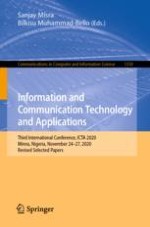2021 | Buch
Information and Communication Technology and Applications
Third International Conference, ICTA 2020, Minna, Nigeria, November 24–27, 2020, Revised Selected Papers
herausgegeben von: Dr. Sanjay Misra, Bilkisu Muhammad-Bello
Verlag: Springer International Publishing
Buchreihe : Communications in Computer and Information Science
